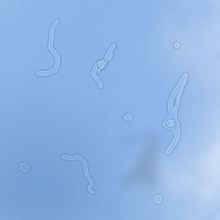
Back عوائم العين Arabic العوامات (مرض) ARZ Очни мътнини Bulgarian Miodesòpsia Catalan Mouches volantes German Μυοψία Greek Flirtantaj muŝoj Esperanto Miodesopsias Spanish مگسپران Persian Lasiaissamentuma Finnish
| Floater | |
|---|---|
 | |
| Simulated image of separated, unclumped floaters against a blue sky | |
| Specialty | Ophthalmology, optometry |
| Differential diagnosis | Migraine aura[1] |
Floaters or eye floaters are sometimes visible deposits (e.g., the shadows of tiny structures of protein or other cell debris projected onto the retina) within the eye's vitreous humour ("the vitreous"), which is normally transparent, or between the vitreous and retina.[2][3] They can become particularly noticeable when looking at a blank surface or an open monochromatic space, such as blue sky. Each floater can be measured by its size, shape, consistency, refractive index, and motility.[2] They are also called muscae volitantes (Latin for 'flying flies'), or mouches volantes (from the same phrase in French).[4] The vitreous usually starts out transparent, but imperfections may gradually develop as one ages. The common type of floater, present in most people's eyes, is due to these degenerative changes of the vitreous. The perception of floaters, which may be annoying or problematic to some people, is known as myodesopsia,[5] or, less commonly, as myodaeopsia, myiodeopsia, or myiodesopsia. It is not often treated, except in severe cases, where vitrectomy (surgery), laser vitreolysis, and medication may be effective.
Floaters are visible either because of the shadows that imperfections cast on the retina,[6] or because of the refraction of light that passes through them, and can appear alone or together with several others as a clump in one's visual field. They may appear as spots, threads, or fragments of "cobwebs", which float slowly before the observer's eyes, and move especially in the direction the eyes move.[3] As these objects exist within the eye itself, they are not optical illusions but are entoptic phenomena (caused by the eye itself). They are not to be confused with visual snow, which is similar to the static on a television screen, although these two conditions may co-exist as part of a number of visual disturbances which include starbursts, trails, and afterimages.
- ^ Johnson, D.; Hollands, H. (2011-11-28). "Acute-onset floaters and flashes". Canadian Medical Association Journal. 184 (4). Canadian Medical Association: 431. doi:10.1503/cmaj.110686. ISSN 0820-3946. PMC 3291672. PMID 22125334.
- ^ a b Cline D; Hofstetter HW; Griffin JR. Dictionary of Visual Science. 4th ed. Butterworth-Heinemann, Boston 1997. ISBN 0-7506-9895-0
- ^ a b "Facts About Floaters". National Eye Institute. October 2009. Archived from the original on March 21, 2022. Retrieved September 8, 2018.
- ^ Archived at Ghostarchive and the Wayback Machine: "Adult Eye Health: Mayo Clinic Radio (5 minutes in to 8 minute talk)". YouTube.
- ^ From Greek μυιώδης "fly-like" (Myiodes was also the name of a fly-deterring deity) and ὄψις "sight."
- ^ American Academy of Ophthalmology. "Floaters and Flashes: A Closer Look" (pamphlet) San Francisco: AAO, 2006. ISBN 1-56055-371-5
© MMXXIII Rich X Search. We shall prevail. All rights reserved. Rich X Search